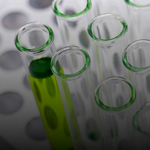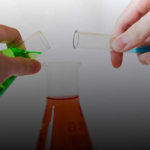Section 1
Preview this deck
selectively permeable
Front
Active users
0
All-time users
0
Favorites
0
Last updated
4 years ago
Date created
Mar 14, 2020
Cards (77)
Section 1
(50 cards)
selectively permeable
allows: small, unchanged, polar molecules; hydrophobic molecules blocks: large polar molecules; ions
ion channels
ions; gated channels
adhesion proteins
attaches cells to cells; provides anchors for filaments
recognition proteins
unique identification; glycoproteins EX: blood types
chloroplasts
(plant cells only) carry out photosynthesis; two membranes
plasma membrane
separates internal metabolic event; controls mvmnt of materials
smooth ER
w/o ribosomes; synthesis of lipids and steroids, metabolizes CHO, detoxification
rough ER
w/ ribosomes; synthesis of proteins and glycoproteins, produces new membrane
lysosomes
(animal cells only) vesicles from Golgi with hydrolytic enzymes; break down material in cytosol for recycling; low pH
mitochondria
carry out cellular respiration; two membranes allow separation of metabolic processes
chromosomes
DNA becomes rod-shaped as cell begins division; includes 2 long DNA molecules and histone proteins
receptor proteins
provide binding sites; activates specific cell response
chromatin
DNA spread through nucleus like web
golgi apparatus
collect, modify, and package proteins, CHO and lipids
gated channels
open and close in response to stimuli EX: nerve and muscle cells
transport proteins
use ATP (active transport) EX: sodium-potassium pump
centrioles
(animal cells only) microtubule organizing centers; create spine apparatus in cell division
nuclear envelope
2 bilipid layers; bounded to nucleus, continuous with ER
peripheral proteins
attached to membrane surface
organelles
bodies within cytoplasm; chemical rxns isolated, able to take place w/o interference; large surface areas to max. space for rxns
cholesterol
stability to animal cells; @ high T=maintain firmness, @ low T=allows flexibility
contractile vacuoles
collect and pump water in cell
microfilaments
made of protein actin; found in cells that move by shape change, e.g. muscle cells; cell motility
carrier proteins
specific molecules bind, changing protein shape
transport vesicles
move materials btwn organelles
histones
organize long DNA
intermediate filaments
support for cell shape
free ribosomes
in cytosol; proteins made function within cell EX: enzymes that catalyze sugar breakdown
cilia
short, many, back-and-forth mvmnt; 9+2 microtubule EX: line respiratory tract
extracellular matrix
(animal cells only) mechanical support, helps bind adjacent cells
aquaporins
channel proteins; increase rate of H20 passage
integral proteins
imbedded in bilipid layer
nucleosomes
coiling of DNA by histones
cell junctions
anchor cells together for cellular exchange
ribosome
2 RNA subunits + proteins; free v bound; protein synthesis
tight junctions
(animals) seal that prevents cellular exchange
unsaturated fatty acid membrane
not packed tight; flexible membrane
nuclear pores
passageway for proteins and RNA
food vacuoles
receive nutrients; usually merge with lysosomes
saturated fatty acid membrane
packed tight; rigid membrane
peroxisomes
animals: breakdown H202, fatty acids, AAs; plants: modify by-products of photosynthesis
nucleus
contains DNA and nucleoli; site of cell division
nucleoli
concentrations of DNA in process of manufacturing ribosomes
channel proteins
passage for hydrophillic substances
anchoring junctions
(animals) protein attachments between cells EX: desmosome
cell walls
(plant cells only) support
bound ribosomes
attached to ER or nuclear envelope; proteins made function within cell membrane or exported from cell
central vacuoles
(plant cells only) contain most of plant cell interior; exert tugor when full for cell rigidity; functions specialized: 1) store starch, nutrients, waste, etc. 2) lysosome function 3) cell growth by absorbing H20 4) renders large SA-to-V ratio
microtubules
made of protein tubulin; found in spindle apparatus (guides chromosome mvmnt in cell division); support and motility for cell activity
flagella
long, few, snake-like mvmnt; 9+2 microtubule EX: sperm
Section 2
(27 cards)



